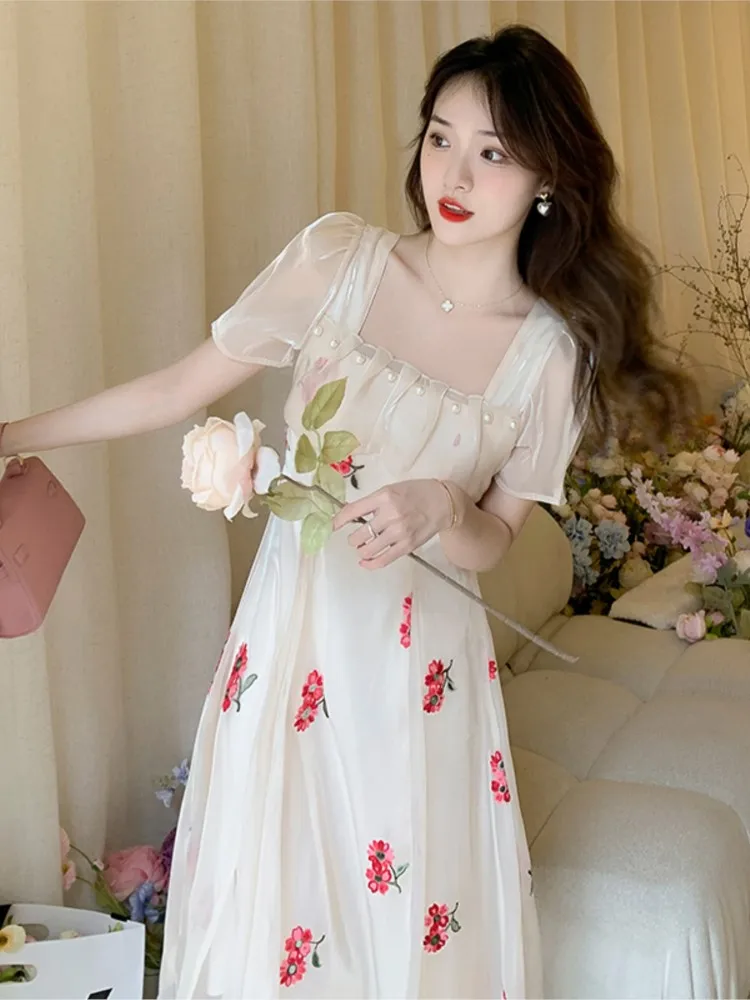Introduction
Embroidered formal dress stand as a testament to timeless elegance and intricate craftsmanship. These garments weave together tradition, culture, and contemporary fashion, resulting in pieces that are both visually stunning and rich in heritage. They have adorned the wardrobes of royalty and commoners alike, transcending eras and fashion trends. This article delves into the fascinating world of embroidered formal dresses, exploring their history, techniques, cultural significance, modern adaptations, and care tips.
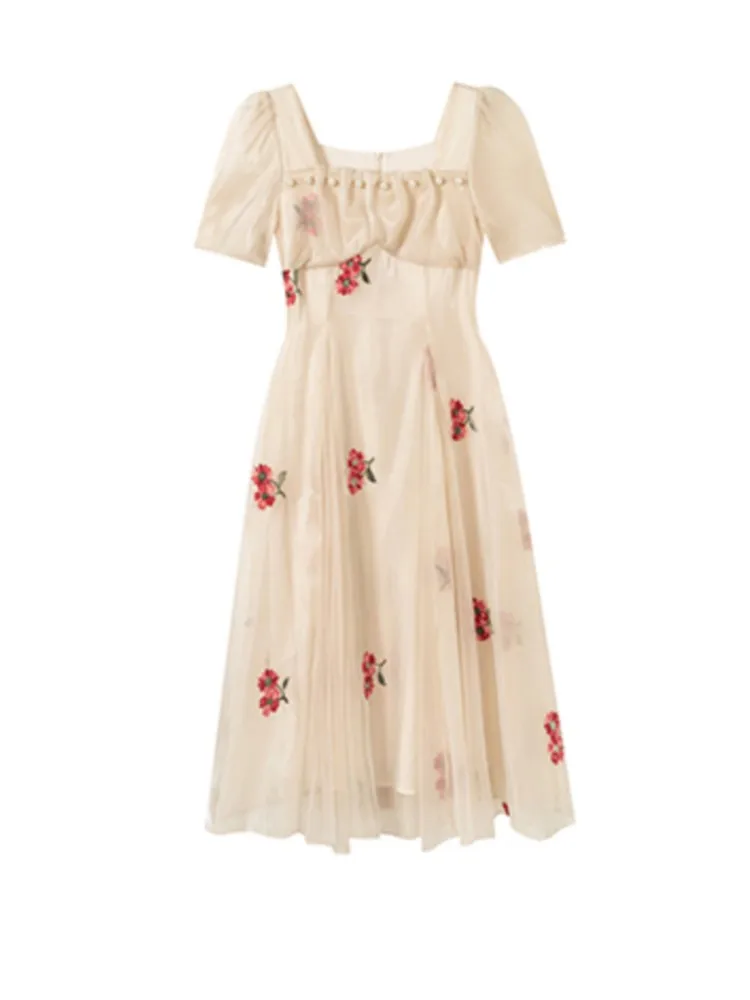
The Historical Significance of Embroidery in Fashion
Embroidery has a long and illustrious history, dating back thousands of years. Early examples come from ancient civilizations like Egypt, China, and Persia. In these cultures, embroidery was more than mere decoration; it symbolized social status, wealth, and power. Kings, queens, and nobility wore heavily embroidered robes to display their opulence and authority.
Roots in Ancient Civilizations
In ancient Egypt, embroidered garments were part of the royal wardrobe. Intricate patterns adorned linens and silks, often depicting religious symbols or scenes from mythology. Similarly, in China, embroidery has been significant since the Han Dynasty (206 BC – 220 AD). The Chinese mastery of silk embroidery produced breathtaking designs, which became central to their cultural identity.
Persian embroidery also boasts a rich history, with artisans creating complex floral and geometric patterns on fabrics. Persian embroidered textiles influenced many neighboring cultures, spreading their techniques and styles across Asia and Europe.
Evolution Through the Ages
During the Middle Ages in Europe, embroidery became closely associated with the Church. Ecclesiastical garments featured elaborate embroidery to convey religious themes and demonstrate the Church’s power. Monasteries often housed skilled embroiderers who crafted these sacred vestments.
As the Renaissance dawned, embroidery flourished in European courts. Royalty and aristocracy commissioned elaborate gowns, cloaks, and doublets adorned with gold and silver thread, pearls, and precious stones. This period saw the advent of new techniques and stitches, further enhancing the art form.
The Industrial Revolution brought about changes in embroidery. Machines could now replicate hand-stitched patterns, making embroidered garments more accessible. However, hand embroidery retained its prestige, symbolizing luxury and exclusivity.
Techniques and Styles of Embroidery in Formal Dresses
Embroidery techniques vary widely, each offering unique textures, patterns, and visual effects. The choice of technique often depends on the fabric, design complexity, and cultural context.
Hand Embroidery: The Artisan’s Touch
Hand embroidery remains highly valued for its precision and personal touch. Skilled artisans painstakingly stitch designs, creating one-of-a-kind pieces. Some common hand embroidery techniques include:
- Surface Embroidery: This involves stitching patterns directly onto the fabric’s surface. Popular stitches include satin stitch, chain stitch, and running stitch.
- Counted Thread Embroidery: In this method, the embroiderer counts the fabric threads to create uniform designs. Cross-stitch and blackwork are examples of counted thread embroidery.
- Needlepoint: Also known as canvas work, this technique uses stiff, open-weave fabric. Patterns are stitched over the base fabric, creating a dense, textured design.
- Whitework: This style uses white thread on white fabric, focusing on texture and subtlety. It includes techniques like Hardanger and Broderie Anglaise.
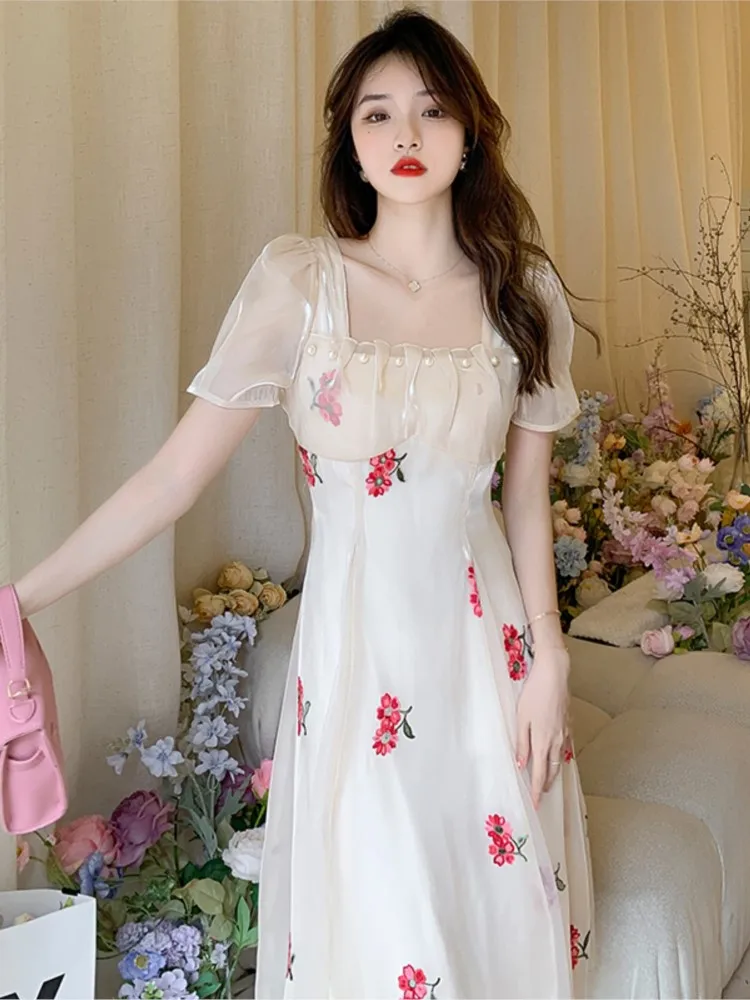
Machine Embroidery: Combining Tradition and Technology
Machine embroidery offers speed and precision, making it ideal for mass production. Modern machines can replicate intricate designs quickly, maintaining high quality. They can handle complex patterns, including those requiring multiple thread colors and textures.
- Computerized Embroidery: This involves using software to digitize designs, which machines then stitch onto the fabric. It allows for precise replication of intricate patterns, suitable for detailed and repeatable designs.
- Free-Motion Embroidery: This technique gives the operator creative control, moving the fabric under the needle manually. It combines the flexibility of hand embroidery with the efficiency of machines.
Cultural Embroidery Styles
Different cultures have developed unique embroidery styles, each reflecting their artistic traditions and societal values.
- Chinese Embroidery: Known for its delicate silk threads and vivid colors, Chinese embroidery features motifs like dragons, phoenixes, and flowers. Techniques such as Suzhou and Hunan embroidery are renowned for their elegance and precision.
- Indian Embroidery: India boasts diverse embroidery styles, including Zardosi (metal embroidery), Phulkari (floral work), and Chikankari (white thread on muslin). Each style represents regional aesthetics and cultural narratives.
- Middle Eastern Embroidery: Rich in history, Middle Eastern embroidery often includes gold and silver threads, beads, and sequins. Palestinian and Moroccan styles are particularly noted for their geometric and floral patterns.
The Cultural Significance of Embroidered Formal Dresses
Embroidered formal dresses are deeply rooted in cultural traditions worldwide. They serve as symbols of identity, heritage, and social status.
Weddings: A Celebration of Heritage
In many cultures, wedding attire features extensive embroidery. Brides wear dresses adorned with intricate designs, often passed down through generations.
- Indian Weddings: In India, bridal wear like sarees and lehengas are richly embroidered with gold and silver threads, beads, and sequins. Each region has distinct styles, like the Banarasi saree or Rajasthani lehenga, showcasing local craftsmanship.
- Chinese Weddings: Traditional Chinese bridal dresses, such as the qipao or cheongsam, often feature elaborate embroidery with auspicious symbols like dragons and phoenixes. Red, symbolizing luck and prosperity, is the preferred color.
- Middle Eastern Weddings: Bridal gowns in the Middle East incorporate luxurious fabrics and heavy embroidery. Palestinian brides, for example, wear elaborately embroidered dresses called “thobes,” which tell stories of their heritage.
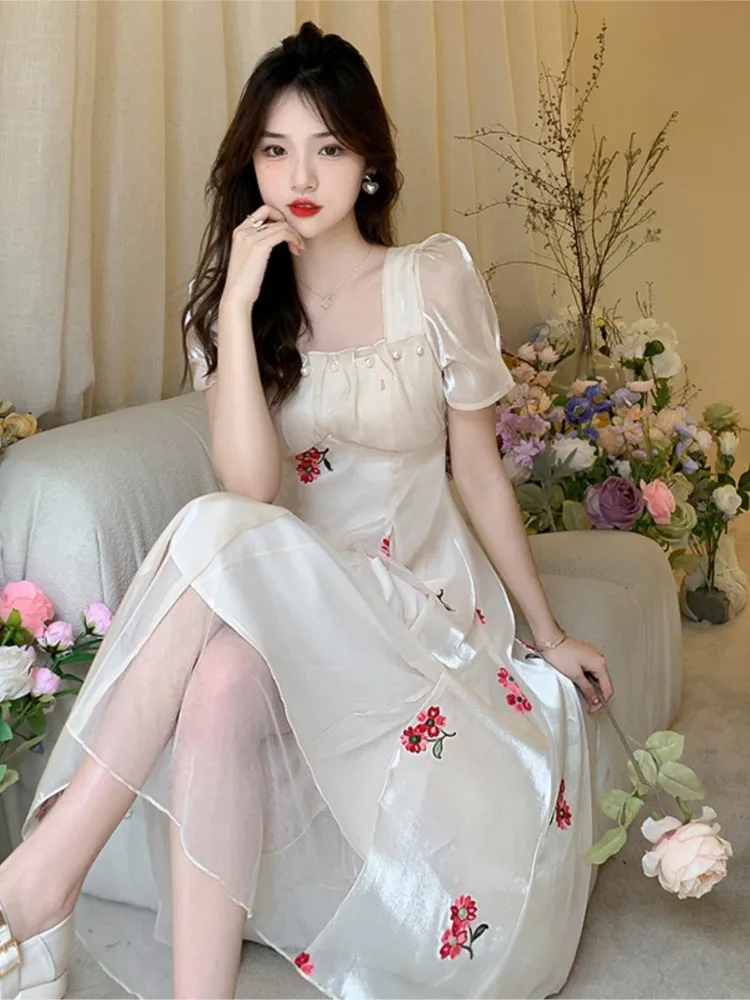
Ceremonial and Festive Attire
Embroidered formal dresses also play a crucial role in ceremonies and festivals.
- Japanese Kimono: The kimono, a traditional Japanese garment, often features embroidery. The motifs can indicate the wearer’s family crest, season, or marital status. Furisode, worn by unmarried women, are particularly ornate.
- African Ceremonial Dress: In Africa, embroidered garments signify cultural pride and status. Nigerian agbada and boubou, for instance, are richly decorated with embroidery, worn during important ceremonies and celebrations.
- European Festive Wear: In Europe, traditional festival costumes often include embroidery. For example, Austrian dirndls and Norwegian bunads feature intricate patterns, reflecting regional identities.
Modern Adaptations and Trends in Embroidered Formal Dresses
Contemporary fashion designers continue to draw inspiration from traditional embroidery, blending it with modern aesthetics.
Fusion of Tradition and Innovation
Modern designers experiment with embroidery techniques, combining traditional methods with innovative materials and technologies.
- High Fashion Runways: Designers like Valentino, Elie Saab, and Alexander McQueen frequently showcase embroidered gowns in their collections. These pieces often feature bold, artistic designs, pushing the boundaries of traditional embroidery.
- Sustainable Fashion: As sustainability gains importance, designers are turning to hand embroidery, promoting slow fashion. Brands like Sabyasachi and Manish Malhotra highlight artisanal craftsmanship, creating timeless pieces that defy fast fashion trends.
- Digital Embroidery: Advances in technology have led to digital embroidery, where computer-aided designs are stitched onto fabrics. This allows for precision and consistency, enabling complex patterns to be produced efficiently.
Everyday Elegance
Embroidered elements are no longer confined to formal occasions. They have found their way into everyday fashion, adding elegance to casual wear.
- Boho Chic: The bohemian fashion trend embraces embroidered details, often inspired by folk art. Embroidered blouses, skirts, and accessories add a touch of artistry to everyday outfits.
- Denim and Streetwear: Embroidery has even made its mark on streetwear. Embroidered denim jackets, jeans, and sneakers offer a unique blend of casual and chic.
- Accessories: Embroidery adorns accessories like handbags, shoes, and scarves. These items allow individuals to incorporate a hint of elegance into their daily ensembles.
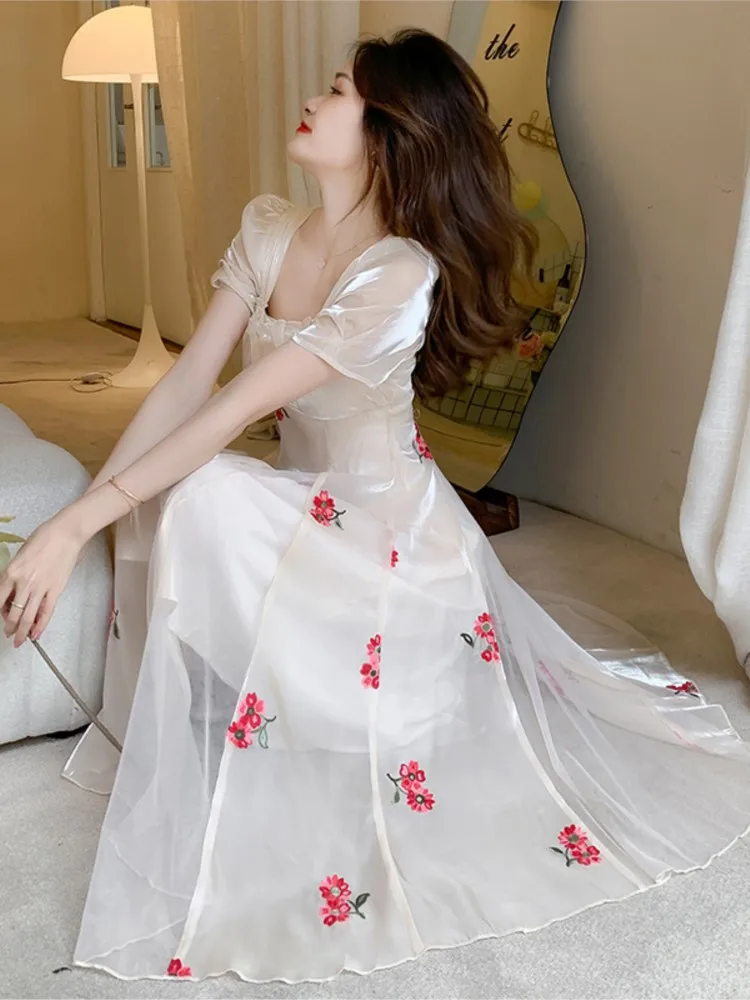
Caring for Embroidered Formal Dresses
Proper care ensures the longevity and beauty of embroidered formal dresses. These garments require special attention due to their delicate fabrics and intricate designs.
Cleaning Tips
Cleaning embroidered dresses can be challenging, especially when dealing with delicate or vintage pieces.
- Hand Washing: When possible, hand wash embroidered garments using mild detergent and cold water. Avoid wringing the fabric; instead, gently press the water out.
- Dry Cleaning: For heavily embellished or vintage dresses, professional dry cleaning is advisable. Inform the cleaner about the embroidery to ensure they take appropriate precautions.
- Spot Cleaning: For minor stains, use a gentle stain remover and a soft cloth. Test on an inconspicuous area first to avoid damaging the embroidery.
Storage Solutions
Proper storage prevents damage and preserves the embroidery’s integrity.
- Hanging vs. Folding: Store heavily embroidered dresses flat to prevent stretching. Use padded hangers for lighter garments to maintain shape.
- Climate Control: Keep garments in a cool, dry place away from direct sunlight. Humidity and heat can damage fabrics and threads.
- Protection: Use breathable garment bags for storage. Avoid plastic bags, as they can trap moisture and cause mildew.
Repair and Maintenance
Regular maintenance helps sustain the embroidery’s beauty.
- Mending: Address loose threads or minor tears promptly. Use matching thread and small, neat stitches to repair damage.
- Professional Restoration: Vintage or heavily damaged pieces may require professional restoration. Seek experts specializing in textile conservation.
The Future of Embroidered Formal Dresses
Embroidered formal dresses will continue to evolve, blending tradition with contemporary fashion trends. Innovations in technology, sustainability, and artistic expression will shape the future of these timeless garments.
Technological Advancements
New technologies will transform embroidery, making it more accessible and innovative.
- 3D Embroidery: 3D printing technology is already influencing embroidery. Designers can create three-dimensional patterns, adding depth and texture to garments.
- Smart Fabrics: Integration of smart textiles with embroidery can lead to interactive garments. For instance, conductive threads can create patterns that respond to touch or light.
- Eco-Friendly Materials: Advances in sustainable materials will influence embroidery. Organic threads, recycled fabrics, and natural dyes will become more prevalent, aligning with eco-conscious fashion trends.
Artistic Exploration
Fashion designers will continue to push the boundaries of embroidery, creating avant-garde pieces.
- Mixed Media: Combining embroidery with other art forms, such as painting or sculpture, will result in unique, multidimensional garments.
- Cultural Fusion: Designers will draw inspiration from diverse cultures, blending traditional techniques with contemporary styles. This fusion will celebrate global heritage and innovation.
- Personalization: Custom embroidery will gain popularity, allowing individuals to express their identity and creativity through personalized designs.
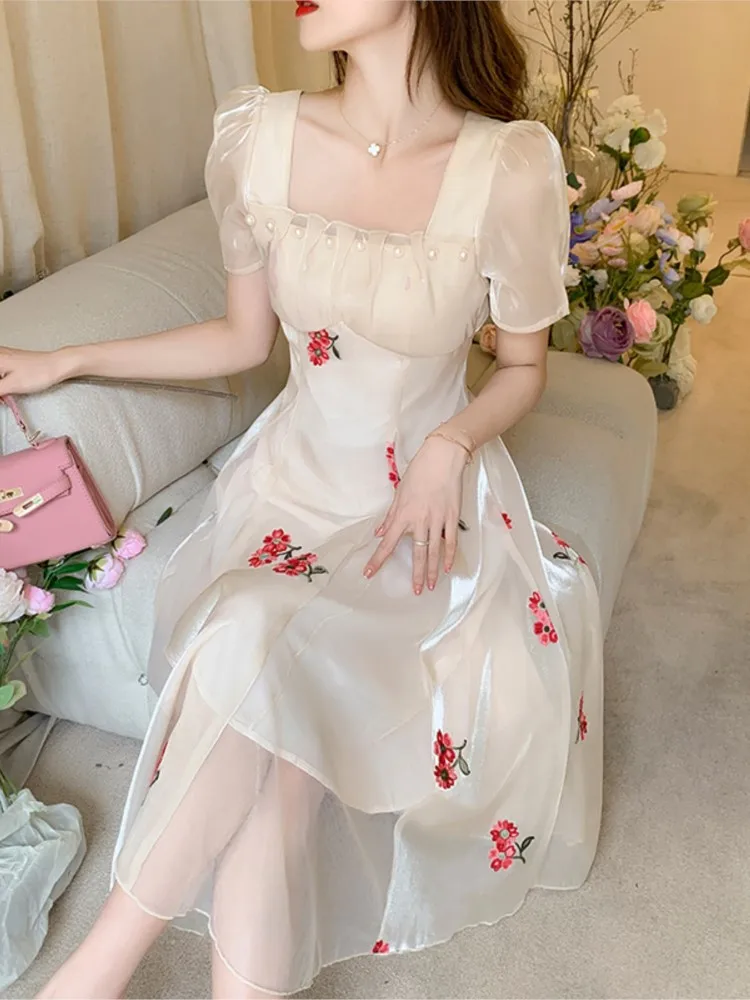
Conclusion
Embroidered formal dresses embody a rich tapestry of history, culture, and artistry. From ancient civilizations to modern runways, they have captivated hearts and minds with their intricate beauty. As fashion evolves, embroidery will continue to play a vital role, bridging the past and future with threads of elegance and innovation. Whether worn at weddings, ceremonies, or as everyday adornments, embroidered dresses remain timeless treasures, celebrating the artistry and heritage of countless generations.
Tags: Classic Elegance Dress